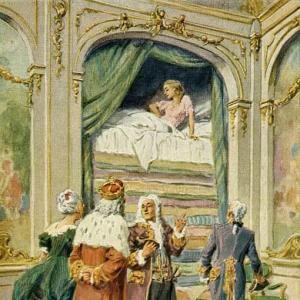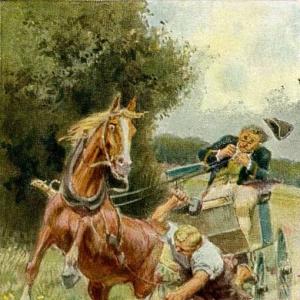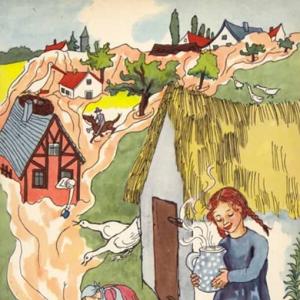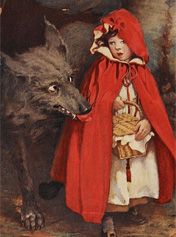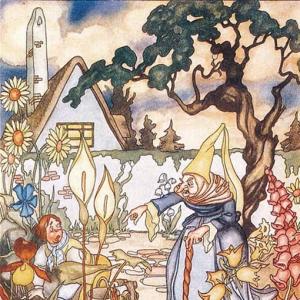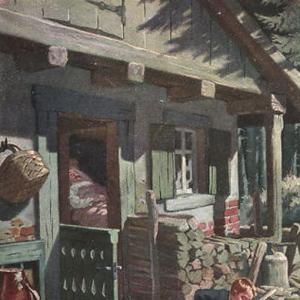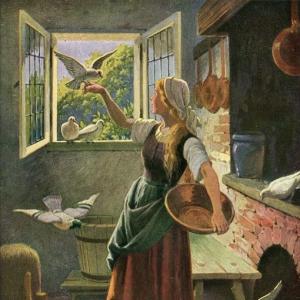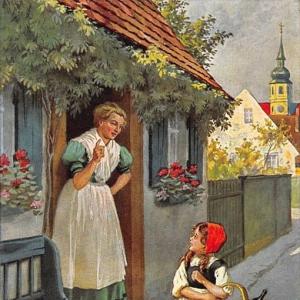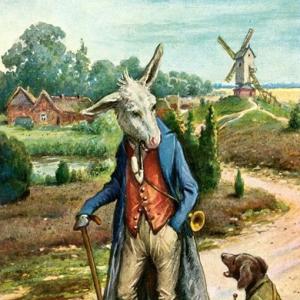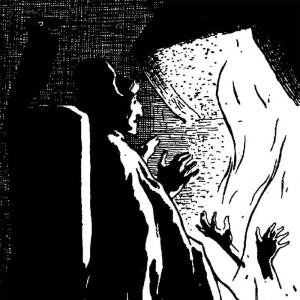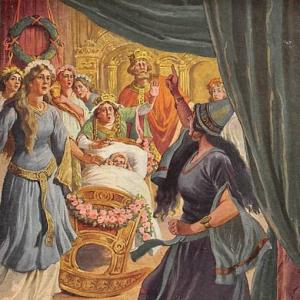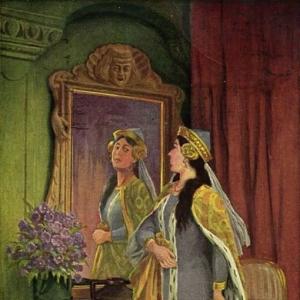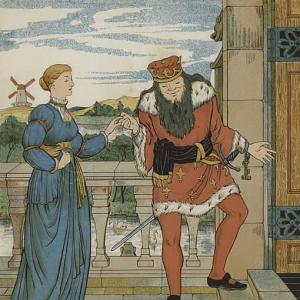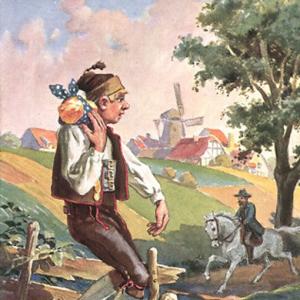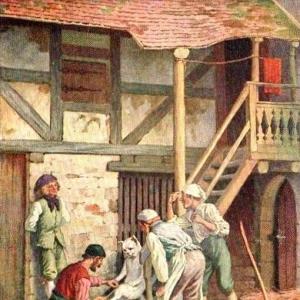Reading time: 3 min
There was once an old woman, but thou hast surely seen an old woman go a-begging before now? This woman begged likewise, and when she got anything she said:
„May God reward you.“
The beggar- woman came to a door, and there by the fire a friendly rogue of a boy was standing warming himself.
The boy said kindly to the poor old woman as she was standing shivering thus by the door:
„Come, old mother, and warm yourself.“
She came in, but stood too near the fire, so that her old rags began to burn, and she was not aware of it. The boy stood and saw that, but he ought to have put the flames out. Is it not true that he ought to have put them out?
And if he had not any water, then should he have wept all the water in his body out of his eyes, and that would have supplied two pretty streams with which to extinguish them.
 Learn languages. Double-tap on a word.Learn languages in context with Childstories.org and Deepl.com.
Learn languages. Double-tap on a word.Learn languages in context with Childstories.org and Deepl.com.Backgrounds
Interpretations
Adaptions
Abstract
Summary
Linguistics
„The Old Beggar Woman“ (KHM 150) is a short story from the collection „Children’s and Household Tales“ by the Brothers Grimm. The tale has a rich background that blends together different elements, including its origin, the social context in which it was created, and the influence of other literary works.
The story originates from Johann Heinrich Jung-Stilling’s autobiography „Heinrich Stillings Jünglingsjahre“ (1778). It was initially a part of a narrative told by Anna, the daughter of Jung-Stilling’s innkeeper. The Brothers Grimm later included it in their collection of fairy tales, though they removed the original framing story. During the late 18th and early 19th centuries, German Romanticism was flourishing, and there was a growing interest in preserving and sharing folktales, legends, and fairy tales. The Brothers Grimm, who were both scholars and authors, played a significant role in this movement by collecting and publishing these stories. Their works often reflected social issues and values, such as the importance of kindness and the consequences of inaction.
In their annotations, the Brothers Grimm drew connections between „The Old Beggar Woman“ and other stories, although some scholars have criticized these comparisons as far-fetched. For example, the brothers referenced „The Beggar Woman of Locarno“ by Heinrich von Kleist and the Germanic god Odin, who appears as Grimnir in a tale where he visits two young men in a royal hall. They speculated that the beggar woman in their story might be seeking revenge through a curse, similar to the characters in these other tales.
However, some literary scholars, like Hans-Jörg Uther, argue that these connections reveal more about the Brothers Grimm’s working methods than the actual content of „The Old Beggar Woman.“ Instead, the story highlights the protagonist’s internal conflict between affection and restraint, leading to passivity and guilt. Overall, the background of „The Old Beggar Woman“ is a complex interplay of its origin, social context, and the influence of other literary works. This richness adds depth to the story and helps to explain why it has endured as a part of the Brothers Grimm’s collection.
The Brothers Grimm collected their stories from various sources, including oral traditions, manuscripts, and printed books. Their primary goal was to preserve the cultural heritage of German-speaking regions and to reflect the cultural identity of the time. Many of their collected stories have roots in older folktales and legends from various European cultures, which were passed down through generations. „The Old Beggar Woman“ is one of over 200 stories included in the Grimms‘ collection. The tale, like many other fairy tales, has a moral lesson at its core. It emphasizes the importance of empathy, responsibility, and resourcefulness. Although it may not be as well-known as other Grimm fairy tales, such as „Cinderella,“ „Snow White,“ or „Hansel and Gretel,“ it still carries an important message for readers about kindness and taking care of those in need.
The Brothers Grimm’s collection has had a significant impact on the development of the modern fairy tale genre, and their stories have been adapted and retold in countless forms over the years. The themes and lessons present in „The Old Beggar Woman“ continue to be relevant and serve as a reminder of the values that many fairy tales aim to impart.
„The Old Beggar Woman“ is a brief and somewhat enigmatic tale from the Brothers Grimm collection. Its interpretations can be diverse, but here are a few common themes and ideas that can be derived from the story:
The power of empathy and compassion: The tale emphasizes the need for empathy and compassion towards others, regardless of their social status. The old beggar woman is in a vulnerable position, and the boy’s lack of empathy contributes to her suffering. By contrasting the boy’s indifference with the idea of shedding tears to put out the fire, the story implies that genuine feelings of empathy and compassion can lead to positive outcomes. The tale emphasizes the need to be kind and compassionate towards others, especially those who are less fortunate. The boy’s initial kindness in inviting the old woman to warm herself serves as an example of how simple acts of empathy can make a difference in someone’s life.
The ambiguity of the beggar woman’s character: The old woman’s character is left somewhat open to interpretation, with the Brothers Grimm speculating in their annotations about a possible curse or act of revenge. This ambiguity allows readers to reflect on their own assumptions and judgments about others, particularly those who appear to be in need or disadvantaged.
The duality of human nature: The story can also be seen as a reflection on the dual nature of human beings. The boy shows both kindness (by inviting the old woman into his home) and indifference (by not helping her when her clothes catch fire). This duality serves as a reminder that people are capable of both good and bad actions, and that we should be mindful of our own behavior and its consequences.
Responsibility and action: The story highlights the importance of taking responsibility for the well-being of others and acting quickly when they are in danger. When the old woman’s clothes catch fire, the boy should have taken immediate action to help her. This aspect of the story serves as a reminder to be proactive in helping others when they are in need.
Consequences of inaction: The tale serves as a warning about the potential consequences of inaction. The boy’s failure to put out the fire on the old woman’s clothes could have led to a tragic outcome. This emphasizes the need to be vigilant and act decisively when faced with dangerous situations. The boy’s failure to act when the old woman’s clothes catch fire highlights the importance of taking action when someone is in need. The story serves as a cautionary tale, reminding readers that inaction can have severe consequences and that it is our responsibility to help others when we can.
Resourcefulness in times of need: The story suggests that, in times of need, we must use all available resources to help others. The mention of the boy using his own tears to extinguish the fire highlights the importance of thinking creatively and resourcefully in challenging situations.
These interpretations of „The Old Beggar Woman“ showcase the richness and depth of this seemingly simple tale. Its themes of empathy, compassion, and the consequences of inaction remain relevant even today, encouraging readers to reflect on their own actions and attitudes towards others.
„The Old Beggar Woman“ is a lesser-known fairy tale collected by the Brothers Grimm, also known as Jacob and Wilhelm Grimm. The Brothers Grimm were German academics, linguists, and cultural researchers who collected and published folklore during the 19th century. Their collection, „Grimms‘ Fairy Tales,“ also known as „Children’s and Household Tales“ („Kinder- und Hausmärchen“ in German), was first published in 1812. While „The Old Beggar Woman“ is not one of the most well-known fairy tales by the Brothers Grimm, and thus has not been adapted as frequently as some other tales, it still has some adaptations and reinterpretations. Here are a few examples.
Theater performance: In 2015, the University of Leeds in the UK performed a selection of lesser-known Grimm’s fairy tales, including „The Old Beggar Woman,“ as part of their Theater Workshop production. The adaptation combined the original story with elements of other Grimm’s tales, providing a fresh perspective on the narrative.
Artwork: Otto Ubbelohde, a German painter and illustrator, created an illustration for „The Old Beggar Woman“ in 1909. His artwork depicts the scene in which the beggar woman’s clothes catch fire, capturing the dramatic moment that serves as the story’s climax. Other artists have also created illustrations for the tale as part of Grimm’s fairy tale collections.
Story reinterpretation: Some authors and storytellers have taken inspiration from „The Old Beggar Woman“ and reimagined the story, adding new characters, plot twists, or themes. These reinterpretations often serve to highlight specific aspects of the original tale or to explore new ideas and perspectives. For example, a writer might retell the story from the perspective of the old beggar woman, offering insights into her motivations and experiences.
Educational resources: „The Old Beggar Woman“ has been used in educational settings to teach students about the themes and moral lessons found in the tale. Teachers might create lesson plans, activities, or discussions centered around the story, helping students to explore ideas such as empathy, compassion, and the consequences of inaction.
While there are not as many adaptations of „The Old Beggar Woman“ as some other Brothers Grimm fairy tales, the story still offers a rich narrative for reinterpretation and exploration in various forms. Its themes and lessons continue to resonate with audiences, providing inspiration for new adaptations and reinterpretations.
„The Old Beggar Woman“ is a short and enigmatic tale from the Brothers Grimm collection. The plot revolves around an old beggar woman who visits a young boy’s home. The boy kindly invites her inside, and she comes in to warm herself by the fire. However, as she gets too close to the flames, her tattered clothes catch fire. Instead of helping her extinguish the fire, the boy stands by and watches the incident unfold. The tale concludes with the narrator emphasizing that the boy should have taken action to put out the fire. If he had no water available, he should have cried enough tears to create two streams that could extinguish the flames. The story serves as a cautionary tale, highlighting the consequences of inaction and the importance of empathy and compassion towards others in need.
„The Old Beggar Woman“ is a fairy tale by Brothers Grimm about an old woman who goes begging from door to door. When she receives any kindness, she thanks the giver by saying, „May God reward you.“ One day, she arrives at a door where a kind-hearted young boy is warming himself by the fire. Seeing the old woman shivering, the boy invites her to come in and warm herself.
The old woman steps in and stands too close to the fire. Her tattered clothes catch fire, but she remains unaware of the danger. The boy, who is still nearby, sees the flames but does not take immediate action to put them out. The story emphasizes that the boy should have done everything in his power to help the old woman, even if it meant using his own tears as a source of water to extinguish the flames.
The tale serves as a lesson about the importance of empathy and taking responsibility to help others in need, highlighting the necessity of being aware of our surroundings and taking action when someone is in danger.
The fairy tale „The Old Beggar Woman“ by the Brothers Grimm offers a rich ground for linguistic analysis. Let’s examine its structure, language, and underlying themes.
Structure
The structure of the tale is quite straightforward, typical of many folk narratives. It begins with the introduction of a character—an old woman who is a beggar. The setting is quickly established, and the action begins immediately, taking the form of an encounter between the old woman and a boy.
Language
Diction and Syntax: The language is simple and direct, characteristic of oral storytelling. The use of the second person („thou hast surely seen“) directly engages the reader, a common technique in traditional tales meant to create intimacy and a conversational tone.
Repetition and Formulaic Expressions: The woman’s repetitive phrase, „May God reward you,“ is formulaic and serves as a kind of refrain, which reflects oral traditions where repetition aids memory and reinforces morals.
Imagery and Symbolism: The imagery in the tale is vivid, particularly with the old woman’s rags catching fire. Fire can symbolize danger and destruction but also warmth and life, reflecting the dual nature of the boy’s gesture.
Direct Address and Rhetorical Questions: The use of rhetorical questions („Is it not true that he ought to have put them out?“) invites the reader to engage with the moral implications of the story, suggesting a didactic purpose.
Themes
Kindness and Responsibility: The tale explores themes of kindness and responsibility. While the boy initially shows kindness by inviting the woman to warm herself, his failure to act when her rags catch fire highlights a deeper moral obligation to help others, beyond superficial gestures.
Moral and Ethical Imperatives: The narrator’s questioning of the boy’s actions implies a moral lesson on empathy and proactive assistance. The boy’s inaction becomes a lesson in the consequences of failing to take full responsibility for the well-being of others.
Consequences of Inaction: The story subtly critiques inaction and suggests that sometimes emotional responses („weeping all the water in his body“) should translate into practical solutions—here, an exaggerated metaphor that emphasizes the boy’s moral failing.
Conclusion
Overall, the fairy tale „The Old Beggar Woman“ employs simple yet effective language to convey a moral lesson on taking responsibility for others‘ wellbeing. Through vivid imagery and engaging narrative techniques, it prompts readers to reflect on the implications of inaction in the face of another’s distress.
Information for scientific analysis
Fairy tale statistics | Value |
|---|---|
| Number | KHM 150 |
| Translations | DE, EN, DA, ES, PT, IT, JA, NL, PL, RU, TR, VI |
| Readability Index by Björnsson | 24.4 |
| Flesch-Reading-Ease Index | 87.5 |
| Flesch–Kincaid Grade-Level | 5.2 |
| Gunning Fog Index | 7.6 |
| Coleman–Liau Index | 6.6 |
| SMOG Index | 6.9 |
| Automated Readability Index | 4.8 |
| Character Count | 848 |
| Letter Count | 631 |
| Sentence Count | 10 |
| Word Count | 166 |
| Average Words per Sentence | 16,60 |
| Words with more than 6 letters | 13 |
| Percentage of long words | 7.8% |
| Number of Syllables | 201 |
| Average Syllables per Word | 1,21 |
| Words with three Syllables | 4 |
| Percentage Words with three Syllables | 2.4% |

 Facebook
Facebook  Whatsapp
Whatsapp  Messenger
Messenger  Telegram
Telegram Reddit
Reddit